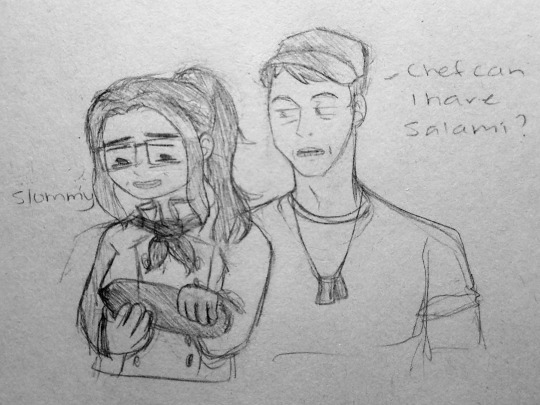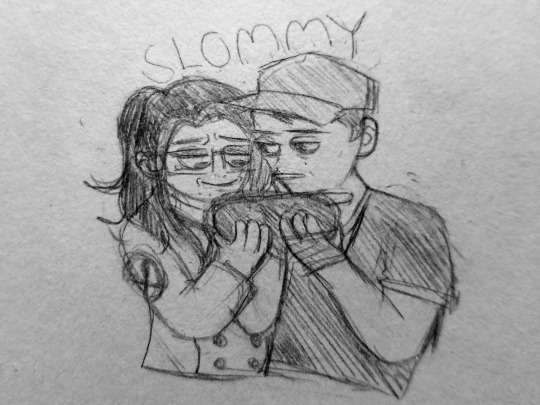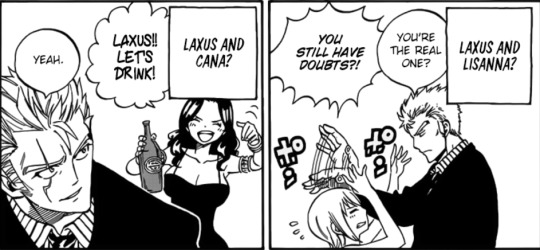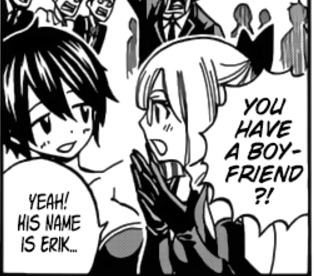#first panel reminds me of that little mermaid comic. you know the one. its his mouth.
Text


slommy
#i was inspired by the post i tagged.#shits and doodles#diner dash 💨#tf2#scout#10th class#self insert#yeah buddy. i enjoy scouts presence. gives me younger brother vibes even though hes older than chef by like who tf knows.#scout reminds me of my own brother but less cool JAJSJDJ but id do the same shit with/to him. like febreze his ass until its wet.#or sit on him until he changes my contact name on his phone#or like...take online quizzes at 2am bc we need to know what our spirit animal is (i was a butterfly btw. he was like a bitch or sumn idk)#first panel reminds me of that little mermaid comic. you know the one. its his mouth.#anyways. this was just scout catching chef kind of dissociating but has shown 0 braincells in them so he thinks its just them being...They.#maybe intense daydreaming. maybe theyre high. he doesnt know but its ok.
16 notes
·
View notes
Text
“Tony de Peltrie” (1985)
The basics: Wikipedia
Opened: A landmark piece of computer animation, the Canadian short was part of the 19th Annual Tournee of Animation anthology that showed at the Vogue Theater in March and April of 1986.
Also on the bill: At least one Saturday in April, it was programmed in the 9:00 slot after Chris Marker’s Akira Kurosawa documentary A.K. and Woody Allen’s Sleeper, and before a midnight showing of Night of the Living Dead, which sounds to me like a very good eight-hour day at the movies. Otherwise, you could have had a less perfect day seeing it play after Haskell Wexler’s forgotten Nicaragua war movie Latino and the equally forgotten Gene Hackman/Ann-Margaret romantic drama Twice in a Lifetime.
What did the paper say? ★★★1/2 from the Courier-Journal film critic Dudley Saunders. Saunders described the Tournee as “a specialized event that shows signs of moving into the movie mainstream,” correctly presaging the renaissance in feature-length animation in the 1990s generally and Pixar specifically, whose Luxo, Jr. short was released that same year. Of Tony, Saunders singles it out as “one of the most technologically advanced,” and that it featured “some delightful music from Marie Bastien.” He then throws his hands up: "Computers were used in this Canadian entry. Don’t ask how.” Saunders was long-time film critic for the C-J’s afternoon counterpart, the Louisville Times, throughout the 1960s, ‘70s and ‘80s. In the late 1980s, he would co-found Louisville’s free alternative weekly, the Louisville Eccentric Observer.
What was I doing? I was six and hypothetically could have seen an unrated animation festival, though I'd have been a little bit too young to have fully appreciated it. Although, who knows, I’m sure I was watching four hours of cartoons a day at the time, so maybe my taste was really catholic.
How do I see it in 2018? It’s on YouTube.
youtube
A four-hour-a-day diet of cartoons was probably on the lower end for most of my peers. I grew up during what I believe is commonly known as the Garbage Age of Animation, which you can trace roughly from The Aristocrats in 1970 to The Little Mermaid (or The Simpsons) in 1989. The quantity of animation was high, and the quality was low. Those twenty years were a wasteland for Disney, and even though I have fond memories of a lot of those movies, like The Black Cauldron, they’re a pretty bleak bunch compared to what was sitting in those legendary Disney vaults, waiting patiently to be released on home video.
Other than low-quality Disney releases, the 1980s were highlighted mostly by the post-’70s crap was being churned out of the Hanna-Barbera laboratories. Either that, or nutrition-free Saturday morning toy commercials like The Smurfs and G.I. Joe. Of course there’s also Don Bluth, whose work is kind of brilliant, but whose odd feature-length movies seem very out-of-step with the times. Don Bluth movies seem now like baroque Disney alternatives for weird, dispossessed kids who didn’t yet realize they were weird and dispossessed. (Something like The Secret of NIMH is like Jodorowsky compared to, say, 101 Dalmatians.) Most of the bright spots of those years were produced under the patronage of the saint of 1980s suburbia, Steven Spielberg. An American Tale or Tiny Toon Adventures aren’t regarded today as auteurist masterpieces of animation (or are they?), but they were really smart and imaginative if you were nine years old. Still, the idea that cartoons might be sophisticated enough to be enjoyed by non-stoned adults was probably very alien concept in 1985.
In the midst of all of this, though, scattered throughout the world were a bunch of programmers and animators working out the next regime. Within ten years of Tony de Peltrie, Pixar’s Toy Story would be the first feature-length CGI animated movie, and within another ten years, traditional hand-drawn animation, at least for blockbuster commercial purposes, would be effectively dead. That went for both kids and their parents. Animation, like comic books, would take on a new sophistication and levels of respectability in the coming decades.
I love it when you read an old newspaper review with the benefit of hindsight, and find that the critic has gotten it right in predicting how things may play out in years to come. That’s why I was excited to read in Saunders’ review of the Tournee that he suspected animation as an artform was showing “signs of moving into the movie mainstream.” His sense of confusion (or wonder, or some combination) at the computer-generated aspects is charming in retrospect, too.
Tony de Peltrie is a landmark in computer-generated animation, but its lineage doesn’t really travel through the Pixar line at all (even though John Lassetter himself served on the award panel for the film festival where it was first shown, and predicted it’d be regarded as a landmark piece of animation). The children of the 1970s and ‘80s grew up to revere the golden era of Pixar movies as adults, and the general consensus is that not only are they great technical accomplishments, but works of great emotional resonance.
As much of an outlier as it makes me: I just don’t know. I haven’t really thought so. I think most Pixar movies are really, really sappy in the most obvious way possible. The oldest ones look to me as creaky as all those rotoscoped Ralph Bakshi cartoons of the ‘70s. Which is fine, technology is one thing -- most silent movies look pretty creaky, too -- but the underlying of armature of refined Disney sap that supports the whole structure strains to the point of collapse after a time or two.
Film critic Emily Yoshida said it best on Twitter: she noted, when Incredibles 2 came out, she’d recently re-watched the first Incredibles and was shocked at how crude it looked. "The technoligization of animation will not do individual works favors over time,” she wrote. “The wet hair effect in INCREDIBLES, which I remember everyone being so excited about, felt like holding a first generation iPod. Which is how these movies have trained people to watch them on a visual level...as technology.” There’s something here that I think Yoshida is alluding to about Pixar movies that is very Silicon Valley-ish in the way they’re consumed, almost as status symbols, or as luxury products. This is true nearly across all sectors of the tech industry now, but it’s particularly evident with animation.
One of my favorite movie events of the year is when the Landmark theaters here in Minneapolis play the Oscar-nominated animated shorts at the beginning of the year. Every year, it’s the same: you’ll get a collection of fascinating experiments from all over the world, some digitally rendered, some hand-drawn. They don’t always work, and some of them are really bad, but there’s always such a breadth of styles, emotions and narratives that I’m always engaged and delighted. They remind you that, in animation, you can do anything you want. You can go anywhere, try everything, show anything a person can imagine. Seeing the animated shorts every year, more than anything else, gets me so excited about what movies can be.
And then, in the middle of the program, there’s invariably some big gooey, sentimental mush from Pixar. Not all of them are bad, and some are quite nicely done, but for the most part, it’s cute anthropomorphized animals or objects or kids placed in cute, emotionally manipulative situations. I usually go refill my Diet Coke or take a bathroom break during the Pixar sequence.
Yeah, yeah, I know. What kind of monster hates Pixar?
I don’t hate Pixar, and I like most of the pre-Cars 2 features just fine. The best parts of Toy Story and Up and Wall-E are as good as people say they are. But when you take the reputation that Pixar has had for innovation and developing exciting new filmmaking technology in the past 25 years, and compare it to the reality, there’s an enormous gap. And it drives me nuts, because if this is supposed to be the best American animation has to offer in terms of innovation and emotional engagement, it's not very inspiring. Especially placed alongside the sorts of animated shorts that come out of independent studios elsewhere in the U.S., or Japan, or France, or Canada.
Which brings us to Tony de Peltrie, created in Montreal by four French-Canadian animators, and supported in part by the National Film Board of Canada, who would continue to nurture and support animation projects in Canada through the twenty-first century. A huge part of the enjoyment -- and for me, there was an enormous amount of enjoyment in watching Tony de Peltrie -- is seeing this entirely new way of telling stories and conveying images appear in front of you for the first time. Maybe it’s because I have clear memories of a world without contemporary CGI, but I still find this enormous sense of wonder in what’s happening as Tony is onscreen. I still remember very clearly seeing the early landmarks of computer-aided graphics, and being almost overwhelmed with a sense of awe -- Tron, Star Trek IV, Jurassic Park. Tony feels a bit like that, even after so many superior technical accomplishments that followed.
Tony de Peltrie doesn’t have much of a plot. A washed-up French-Canadian entertainer recounts his past glories as he sits at the piano and plays, and then slowly dissolves over a few minutes into an amorphous, impressionistic void. (Part of the joke, I think, is using such cutting-edge technology to tell the story of a white leather shoe-clad artist whose work has become very unfashionable by the 1980s.) It’s really just a monologue. The content could be conveyed using a live actor, or traditional hand-drawn animation.
But Tony looks so odd, just sitting on the edge of the Uncanny Valley, dangling those white leather shoes into the void. Part of the appeal is that, while Tony’s monologue is so human and delivered in such an off-the-cuff way, you’re appreciating the challenge of having the technology match the humanity. Tony’s chin and eyes and fingers are exaggerated, like a caricature, but there’s such a sense of warmth underneath the chilliness of the computer-rendered surfaces. Though it’s wistful and charming, you wouldn’t necessarily call it a landmark in storytelling -- again, it’s just a monologue, and not an unfamiliar one -- but it is a technological landmark in showing that the computer animation could be used to humane ends. It’d be just as easy to make Tony fly through space or kill robots or whatever else. But instead, you get an old, well-worn story that slowly eases out of the ordinary into the surreal, and happens so gradually you lose yourself in a sort of trance.
As Yoshida wrote, technoligization of animation doesn’t do individual works favors over time. To that end, something like Tony can’t be de-coupled from its impressive but outdated graphics. These landmarks tend to be more admired than watched -- to the extent that it’s remembered at all, it’s as a piece of technology, and not as a piece of craft or storytelling.
Still, Tony is the ancestor of every badly rendered straight-to-Netflix animated talking-animals feature cluttering up your queue, but he’s also the ancestor of any experiment that tries to apply computer-generated imagery to ways of storytelling. In that sense, he has as much in common with Emily in World of Tomorrow as he does with Boss Baby, a common ancestor to any computer-generated human-like figure with a story. When Tony dissolves into silver fragments at the end of the short, it’s as if those pieces flew out into the world, through the copper wires that connect the world’s animation studios and personal computers, and are now present everywhere. He’s like a ghost that haunts the present. I feel that watching it now, and I imagine audiences sitting at the Vogue in 1986 might have felt a stirring of something similar.

2 notes
·
View notes
Text
Chapter 545 Blow-by-blow
Man, the first and only time I actually do one of these is for the last freakin’ chapter of the series. But I don’t really want to skip it--can’t let this opportunity to sum things up pass.
I’m happy Lucy is going for her dream and is successful at it. I can think of female protagonists who got done dirtier with their endings.
Gray and Natsu squabble, Erza smacks them. I guess that’s what we get for our “lmao things never change” bit, perhaps?
Keep your fucking clothes on, Juvia.
“The award ceremony is ruined.” I take it back, Lucy got done dirty. Her shitty friends can’t even act right for a couple hours to let her celebrate achieving one of her lifelong goals.
Gajevy pregnancy. Delightful.
Chelia’s magic is coming back. I would make a bigger deal out of this, but I’m actually not that mad. I can only assume that Third Origin lost her her magic by burning out her body’s ability to absorb Ethernano--something Wendy could heal.
I just realized why Minerva wins Sabertooth’s eating contest without getting comically obese--she made a pocket dimension out of her stomach with her Territory magic, that cheating bitch!
Mermaid Heel became exclusive models for Sorceror Weekly. Because what else would an all-female guild exist for? Fuck you, Mashima.
Juvia is still trying to take her clothes off.
Under the Imperius Curse, Gray declares Juvia’s body “his”. I know he’s under the Imperius Curse because only someone who thinks women’s bodies are possessions for men, like Mashima, would make such a respectful man say that. Oh, and canon Gruvia I guess. Sigh.

And that is what I call shutting down Miraxus hard. You did something right for once in your life, Mashima.


What a smug little shit, he knows all the women want him.

I’m almost positive that little comment by Erza is Mashima talking about angry fans. You sure told us, Mashima. However will we recover? While we’re talking about Erza, has Mashima always drawn her with that 2014-anime eye-somehow-visible-past-hair thing? Or is that new?
Princess Hisui is queen, and shock of shocks, actually did something useful with the title instead of prettily standing there crying about all the things she’s done wrong with her life.
Crime Sorciere were rewarded. While the Seis do deserve all the rewards, I have to wonder what exactly they accomplished? At all? They didn’t do anything for the entire war.
I’m not sure what Erza brushing her hair means. It was framed like it was supposed to be some sort of character-develop-ey thing, but I’m still not sure what it means.
Doranbolt’s actually here, pushing around Makarov’s wheelchair.
No, seriously, how the fuck are Zeref and Mavis here? And why would they be here? Even if they magically reincarnated and don’t know each other again, wouldn’t someone recognize Zeref as, you know, the person who started the war? A war criminal and tyrannical emperor? Arrest him, damn you!
Naturally, nobody questions it. They’re used to people coming back from the dead by now.
Levy is still ignoring the fuck out of her two “friends”. What else is new?


YOU FUCKING DID IT, MASHIMA. YOU DID THE ONE THNG I BEGGED YOU NOT TO ABOVE ALL OTHERS. YOU HAD ERIK FUCK THE SNAKE FRIEND. I’M COMING OVER TO JAPAN RIGHT NOW TO SHOVE AN IRON PEG UP YOUR ASS FOR THAT, YOU TRASHY PIECE OF SHIT.
At least Alzack and Bisca are happy.

Hmm.
I know I am mentioning @ac-fairytail a lot lately, but if I’m not wrong, they’re on the money again. Didn’t you predict this would be one of the “lmao things never change” panels?
A bunch of flashback panels as Lucy reflects on her time spent with Natsu. Shame I can’t really enjoy them.
I’m actually really touched by Lucy thanking Natsu for being a part of her life. That is how you write two people being close together, Mashima. Not with titties.
Of all the shippers to troll, Mashima trolled the Nalu ones. Can’t we trade out Nalu for Gruvia? Is it too late for that? Or maybe trade them all for Kinabra? You could canonize all four big 4 with kids and I would take it happily just to get that Kinabra out of my face.
My appreciation of the moment is ruined by the fact that Natsu literally goes through Lucy’s panties when she’s asleep. Fuck you, Natsu.
Natsu and the group are going on a 100-year quest. I assume what’s going to take 100 years about it is rebuilding all of the destruction they’ve wrought over the course of the manga. Also seems like the only way they’d actually get a 100-year job.

I DON’T KNOW, MASHIMA? DO THEY? YOU SEEMED MUCH TOO CONCERNED WITH SHOVING DRAGONS UP MY ASS TO EVEN BRING UP THE NOTION OF FAIRIES MORE THAN A COUPLE TIMES. THE MOST IMPORTANCE THEY’VE EVER GOTTEN IS BEING SOMETHING MAVIS LOOKS FOR AND BEING SOMETHING EVERGREEN LIKES. PRETTY SURE THIS MANGA’S NAME IS ‘FAIRY TAIL’ NOT BECAUSE IT’S AN ETERNAL ADVENTURE (IT WAS AN ETERNAL NIGHTMARE), BUT BECAUSE IT WAS A PUN. YOU THINK YOU’RE CLEVER, AND YOU’RE NOT.
I’m glad you can thank the fans that stuck with you for 11 years, Mashima, and I know I should shut up, since you’re not talking to me--I was only with it for two and a half years. But since you’re starting a new work, I’ll remind you that the people who stuck with Fairy Tail to the end only did so out of A) a masochistic, miserable desire to finish something they started or B) to see you finally canonize their ships, and frankly neither party ended up all that pleased.
Welp......that’s it. That’s the end of Fairy Tail....It’s a weird feeling, actually seeing the final page of a manga. I don’t think I’ve done that since Hellsing, and I hated Hellsing and especially its ending, so I don’t remember feeling anything but relief that it was over. Hellsing was a lot shorter than Fairy Tail though--about five times shorter--and took about three days for me to fully read, so I didn’t get this weird feeling that something that was a part of my life is now over.
At least it’s done.
96 notes
·
View notes